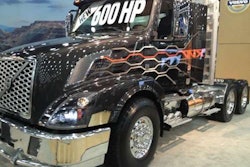Mention the word “rail” to a group of drivers or fleet executives, and you’re sure to see some hackles raised. When Clayton, Ala.-based Boyd Bros. – the 2013 CCJ Innovator of the Year and the April issue’s cover story – added intermodal service to its portfolio, the flatbed company’s decision certainly had its detractors within the trucking industry as some fleets feared the innovation has the potential to drive flatbed rates down and drivers feared losing jobs.
“More money to the railroad, less money to the trucking industry,” complained one person on CCJ’s Facebook page. “Yet another knife is driven into the back of the American truck driver,” said another.
Despite all the complaints and misconceptions, some fleets are turning to rail – and more specifically intermodal service – to offset a litany of headwinds including the driver shortage, high fuel prices and expected productivity losses courtesy of the new hours-of-service rule set to take effect in July, barring an 11th-hour stay by the Department of Transportation.
Fleets using intermodal are hardly turning their back on their trucking roots, as some would believe. Instead, they see it as an opportunity to enter new geographical markets, increase existing capacity and ultimately improve service to customers. As Boyd Bros. president Richard Bailey puts it, “We move freight that fits on a 48- or 53-foot flatbed trailer. Any way we can move that freight we’ll move it.”
And rail companies have steadily improved infrastructure and intermodal service and obviously are waiting with open arms to partner with fleets. During a fleet panel discussion at the Truckload Carriers Association’s Annual Convention, both Derek Leathers, president and chief operating officer of Werner Enterprises, and Dan England, chairman of C.R. England, both said that intermodal was the fastest growing portion of their businesses.
“The intermodal conversion is here to stay,” said Leathers. “If we put our head in the sand and attempt to ignore it or defend freight that could go intermodal and keep it on a truck, that story probably doesn’t end well.”
England says one overlooked benefit of offering intermodal service is the ability to provide better job opportunities for drivers.
“I think with long-haul freight, keeping your drivers away from home so long, that’s where we have so much difficulty with driver turnover,” said England. “[Intermodal] is just an alternative for that where we have local drivers on two ends and those tend to be very good jobs.”
Fellow panelist Max Fuller, chairman and chief executive officer of U.S. Xpress Enterprises, which offers container on flat car and trailer on flat car intermodal service, says that much of the long-haul conversion to rail in the last decade will remain, but fuel prices ultimately dictate how freight is moved for time-sensitive freight.
“What really moved a lot of freight to rail was fuel prices and higher cost of transportation to customers,” said Fuller. “We still see a lot of that today. When fuel prices are lower, freight that was moved via intermodal starts to move back to truck. When fuel prices go up, you put it back on rail.”
As the trucking industry continues to face capacity constraints and regulatory burdens, intermodal offers another way to serve its customers without interruption, at least in the right lanes and applications.













